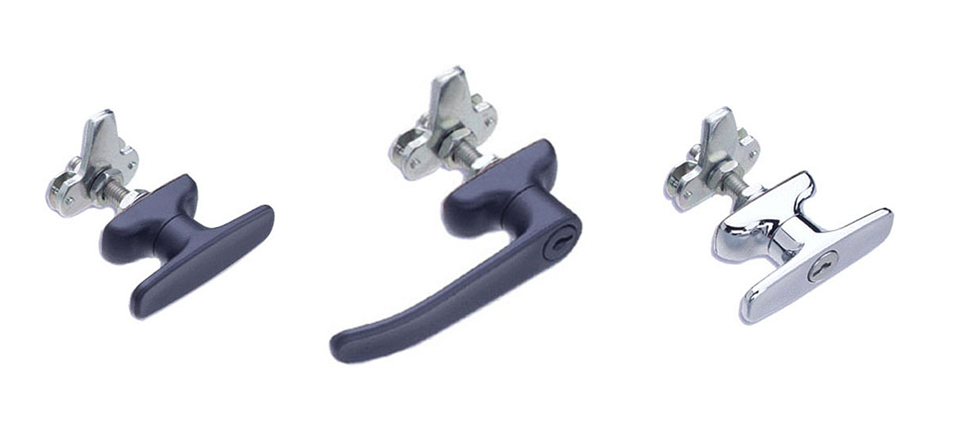How Compression and Cam Latches Can Simplify Enclosure Access
Articles, Quarter-turns

Have you ever taken the time to think about why the dawn of Netflix marked the end of the Blockbuster era?
Or why small mom-and-pop shops hate when a Wal-Mart moves into town?
Convenience and accessibility.
As humans, we want to get as much done with as little effort as possible. Why visit multiple stores when we can get everything we need in one? Why go out to rent a movie when I can have them delivered to me (Netflix’s model pre-streaming), or enjoy from a streaming app?
Heck, why even go to Wal-Mart when Amazon Prime can send whatever I need to my home overnight?
As technology continues to evolve, we as a society will continue to streamline our actions and activities to reach our goals in as little time and with as little effort as possible.
Which leads us to exactly why compression and cam latches stand out within industrial applications and enclosures.
Convenience and accessibility.

What is a Cam Latch?
Let’s start at the beginning, which ironically starts with our great late founder, Dieter Ramsauer. In 1967, Dieter Ramsauer invented the modularly designed cam latch
This upgraded modular design is the cam latch as we know it today, featuring interchangeable components which allowed for the swapping of the insert, housing, and cam to fit nearly any application.
Seeing as quarter-turns were designed to be used as quick and reliable security devices for panels, lockers, doors, and virtually any other enclosure – these latches are actually quite complex.
Now before you ask, “Well what’s the difference between a cam latch and a quarter-turn?”
Spoiler alert: There aren’t any.
A cam latch is also commonly referred to as a quarter-turn, due to regional nomenclature/name differences.
Now that we got that covered, here’s a high level overview of what makes up a cam latch:
- Cam latches are made up of a main unit that is connected to a moving cabinet, window, or panel, and a rotating ‘cam lever’ that can engage or disengage a non-moving frame or fixed panel.
- This cam lever can be activated with a simple twisting motion by hand or key.
- So when the door or window is shut, that same rotating lever can rotate behind the door frame or panel, keeping the door from opening and effectively securing the door shut.
And that’s cam latches 101.
Now let’s talk about compression latches.
What is a Compression Latch?
Compression latches stand out amongst their peers for a number of reasons.
They were specifically designed to seal electrical enclosures or industrial applications effectively against moisture and dust, while also eliminating unnecessary rattling noises caused by panel vibrations or movements.
Compression latches provide enough pressure to compress a gasket until it is sealed completely shut and resistant against natural elements such as wind, dust, and water, eliminating any chance of panels moving away from the frame.
Just like last time, let’s get into a high level overview of what makes up a compression latch:
- Compression latches are composed of a moving panel or door, an attached body, and a cam lever.
- Said cam lever is used to engage a non-moving or fixed panel to the moving panel or door.
When the moving panel or door is closed, the cam lever is then firmly locked behind the non-moving panel to secure the panels together.
And that’s a quick refresher on compression latches.

What is the advantage of using a hand-operated latch?
Using either compression latches or cam latches when designing enclosures will allow operators fast and efficient access to a panel or door. Depending on the industry and intention for the enclosure, quick access may take priority over increased security.
Which is where hand-operated compression or cam latches shine, as these styles of latch can make a world of difference as they are very simple for operators to actuate, quickly.
Integrating a hand-operated latch will not only eliminate the need for a handle on your enclosure, but it also provides the fastest possible access to your enclosure.
For example, if an operator needs to open an enclosure that features a hand-operated compression latch, he can rotate the latch and pull the door open with one hand, in a single motion!
Hand-operated cam and compression latches are also the ideal component in environments in which the operators must wear gloves.
Handles and latches that require keys and tools to actuate can pose significant difficulties to a gloved hand, or cause the operator to remove their glove and risk damaging their hand.
If you’re looking for increased safety in your application, hand-operated cam and compression latches can be installed within a cup-style mounting, causing the latch to be flush with the door (helping to avoid anything getting caught on the latch) as well as increasing its grip point.

Wrapping Things Up…
DIRAK has a vast line of compression and cam latches on offer, including a wide range of hand-actuated head components that can effectively improve the efficiency, functionality, and speed of enclosure access.
Not to mention you could integrate these hand-operated latches with DIRAK’s various locking mechanisms for additional security.
Here at DIRAK, not only do we meet industry standards for reliability, safety, and weather-resistance, we pioneered it.
Read more about how our founder invented the modern cam latch, and continued to pioneer the industry by crafting custom hardware with precision.
DIRAK offers some of the most revolutionary and innovative latches in the industry today. Don’t hesitate to fill out the contact us form below to discover the perfect solution for you.
